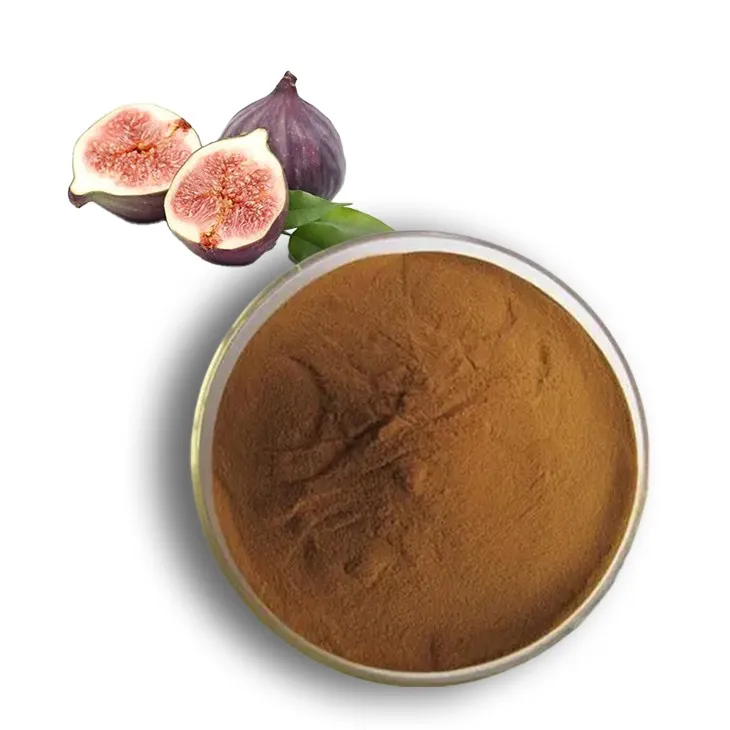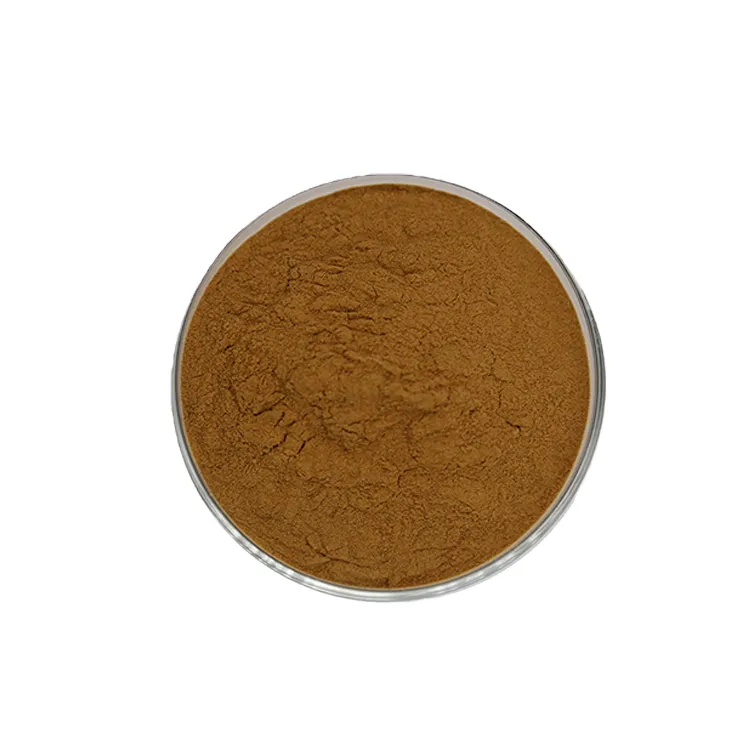- 0086-571-85302990
- sales@greenskybio.com
Fig Extract: Uses, Advantages and Manufacturing Processes
2024-11-12

1. Introduction
The fig, a fruit with a long history of human consumption and utilization, has given rise to an extract that is increasingly becoming a subject of great interest. Fig Extract is derived from the fig fruit through various extraction methods. This extract contains a rich blend of compounds that contribute to its diverse uses and advantages.

2. Uses of Fig Extract
2.1 In Traditional Medicine
Fig Extract has a long - standing history in traditional medicine systems around the world. In ancient medicine, figs were often used to treat a variety of ailments. For example, in some traditional Middle Eastern medicine practices, fig extract was used to soothe digestive problems. It was believed to have properties that could relieve constipation and improve overall digestive function. The high fiber content in figs, which is also present in the extract, was thought to play a key role in this regard.
In traditional Chinese medicine, fig extract was sometimes used in herbal remedies. It was associated with promoting lung health and was used in formulations to treat coughs and respiratory problems. The bioactive compounds in the fig extract were considered to have a nourishing effect on the lungs.
2.2 In the Dietary Supplement Industry
In modern times, fig extract has found a significant place in the production of dietary supplements. One of the main reasons is its rich nutritional profile. Fig extract is a source of vitamins, such as vitamin A, vitamin C, and several B - vitamins. These vitamins are essential for maintaining good health, including supporting the immune system, promoting healthy skin, and aiding in energy metabolism.
Moreover, fig extract contains minerals like potassium, calcium, and magnesium. Potassium is important for maintaining proper heart function and regulating blood pressure. Calcium is crucial for strong bones and teeth, while magnesium is involved in numerous biochemical reactions in the body. Dietary supplements containing fig extract can help individuals meet their daily requirements of these important nutrients, especially those who may have a deficiency or an inadequate diet.
2.3 In Cosmetics
Fig extract has also made its way into the cosmetics industry. It is used in various skincare products due to its potential benefits for the skin. The antioxidants present in fig extract, such as phenolic compounds, can help protect the skin from damage caused by free radicals. Free radicals are unstable molecules that can damage skin cells, leading to premature aging, wrinkles, and other skin problems.
Fig extract also has moisturizing properties. It can help keep the skin hydrated, which is essential for maintaining a healthy skin barrier. This makes it a valuable ingredient in moisturizers, creams, and lotions. Additionally, some research suggests that fig extract may have anti - inflammatory properties, which could be beneficial for treating skin conditions like acne and eczema.

3. Advantages of Fig Extract
3.1 Environmentally Friendly
One of the notable advantages of fig extract is its environmentally friendly nature. Figs are generally grown in a relatively sustainable manner. They are often cultivated in regions with suitable climates without requiring excessive use of pesticides or fertilizers compared to some other crops. This means that the production of fig extract has a lower environmental impact in terms of chemical pollution.
Furthermore, figs are a perishable fruit, and using them to produce extract is a way to add value to the fruit and reduce waste. Instead of figs going to waste if not consumed in time, they can be processed into extract, which can be stored and used for various purposes over a longer period.
3.2 Stable Chemical Composition
Fig extract has a relatively stable chemical composition. The compounds present in the extract, such as sugars, acids, and bioactive substances, are relatively stable under normal storage and processing conditions. This stability is important for its use in various products.
For example, in dietary supplements, the stable chemical composition ensures that the nutrients and active ingredients are preserved during manufacturing, storage, and consumption. In cosmetics, it allows the product to maintain its efficacy over time. The stability also makes it easier to standardize the production process, as the properties of the extract are more predictable.

4. Manufacturing Processes of Fig Extract
4.1 Harvesting of Figs
The first step in the manufacturing process of fig extract is the harvesting of figs. Figs are typically harvested when they reach the appropriate level of ripeness. The timing of the harvest is crucial as it affects the quality of the extract. Figs that are too ripe may have over - ripened and started to decay, while those that are not ripe enough may not contain the full complement of desired compounds.
Harvesting methods can vary depending on the scale of production. In small - scale or traditional farming, figs may be hand - picked to ensure that only the ripe fruits are selected. In large - scale commercial operations, mechanical harvesting methods may be employed, but care must be taken to minimize damage to the figs during the process.
4.2 Preparation of Figs for Extraction
Once the figs are harvested, they need to be prepared for extraction. This involves cleaning the figs to remove any dirt, debris, or unwanted parts such as stems. After cleaning, the figs may be dried or used fresh, depending on the extraction method.
Drying figs can help concentrate certain compounds and also make them easier to store before extraction. However, some extraction methods may require the use of fresh figs to preserve certain heat - sensitive compounds. In some cases, the figs may be chopped or crushed into smaller pieces to increase the surface area for extraction.
4.3 Extraction Methods
There are several extraction methods for obtaining fig extract:
- Solvent Extraction: This is a common method. A suitable solvent, such as ethanol or water, is used to extract the compounds from the figs. Ethanol is often preferred as it can dissolve a wide range of compounds, including many of the bioactive substances in figs. The figs are soaked in the solvent for a period of time, and then the solvent is separated from the solid residue. The resulting solution contains the fig extract, which can then be further processed to concentrate the extract or remove the solvent.
- Press Extraction: In this method, mechanical pressure is applied to the figs to extract the juice or extract. This can be done using a press, similar to those used in the juice industry. Press extraction can be a more natural method as it does not involve the use of solvents. However, it may not be as efficient in extracting all the compounds compared to solvent extraction.
- Supercritical Fluid Extraction: This is a more advanced extraction method. Supercritical fluids, such as supercritical carbon dioxide, are used. Supercritical fluids have properties between those of a gas and a liquid. They can penetrate the fig material more effectively and selectively extract certain compounds. This method is often used when a high - quality, pure extract is desired, especially for use in high - end products like pharmaceuticals or high - quality cosmetics. However, it requires more specialized equipment and is more costly.
4.4 Purification and Concentration
After the initial extraction, the fig extract may need to be purified and concentrated. Purification is done to remove any impurities, such as remaining solid particles or unwanted compounds that may have been extracted along with the desired ones. This can be achieved through filtration, centrifugation, or other separation techniques.
Concentration is important to increase the potency of the extract. This can be done by evaporating the solvent (in the case of solvent extraction) or by other means such as freeze - drying. The final product should have a high concentration of the active and beneficial compounds found in figs.
5. Future Potential of Fig Extract
The fig extract has significant potential for further development in the future. In the field of medicine, ongoing research may uncover new bioactive compounds in fig extract with potential therapeutic effects. For example, there could be compounds that have anti - cancer or anti - neurodegenerative properties that are yet to be fully explored.
In the food and beverage industry, fig extract could be used in more innovative ways. It could be incorporated into functional foods and beverages that target specific health needs. For instance, a sports drink enhanced with fig extract could provide additional nutrients and energy - boosting properties.
In the cosmetics industry, as consumers become more demanding for natural and effective skincare products, fig extract could be further developed into more advanced formulations. It could be combined with other natural ingredients to create more potent anti - aging or skin - rejuvenating products.
6. Conclusion
Fig extract is a versatile substance with a wide range of uses, significant advantages, and a well - defined manufacturing process. Its uses in traditional medicine, dietary supplements, and cosmetics are well - established, and its environmentally friendly nature and stable chemical composition make it an attractive option for various industries. With ongoing research and development, the future potential of fig extract is promising, and it is likely to play an even more important role in different sectors in the years to come.
FAQ:
What are the main uses of fig extract?
Fig extract has multiple uses. In traditional medicine, it has a long history of being used. Industrially, it can be used in the production of dietary supplements.
What are the advantages of fig extract?
The advantages of fig extract include being environmentally friendly and having a relatively stable chemical composition. It also has the potential for the development of more innovative products in the future.
How is the manufacturing process of fig extract?
The manufacturing process of fig extract is designed to preserve its active ingredients, but specific details may vary depending on different production techniques and requirements.
Can fig extract be used in other fields?
While it is known for its uses in traditional medicine and dietary supplement production, there may be potential for it to be explored in other fields as well, such as in the development of new cosmetic ingredients or in certain food applications, but further research is needed.
What makes fig extract environmentally friendly?
The exact reasons for fig extract being environmentally friendly may be related to its natural origin and the relatively low - impact manufacturing processes involved in its extraction. However, more in - depth research may be required to fully understand all the aspects.
Related literature
- The Chemical Composition and Therapeutic Properties of Fig Extract"
- "Manufacturing Techniques for High - Quality Fig Extract"
- "Fig Extract: A Promising Ingredient in Dietary Supplements"
- ▶ Hesperidin
- ▶ Citrus Bioflavonoids
- ▶ Plant Extract
- ▶ lycopene
- ▶ Diosmin
- ▶ Grape seed extract
- ▶ Sea buckthorn Juice Powder
- ▶ Fruit Juice Powder
- ▶ Hops Extract
- ▶ Artichoke Extract
- ▶ Mushroom extract
- ▶ Astaxanthin
- ▶ Green Tea Extract
- ▶ Curcumin
- ▶ Horse Chestnut Extract
- ▶ Other Product
- ▶ Boswellia Serrata Extract
- ▶ Resveratrol
- ▶ Marigold Extract
- ▶ Grape Leaf Extract
- ▶ New Product
- ▶ Aminolevulinic acid
- ▶ Cranberry Extract
- ▶ Red Yeast Rice
- ▶ Red Wine Extract
-
Lotus leaf extract
2024-11-12
-
Milk Thistle Extract
2024-11-12
-
Lemon Juice Powder
2024-11-12
-
Rosemary extract
2024-11-12
-
Peppermint Oil
2024-11-12
-
Lily extract
2024-11-12
-
Aminolevulinic acid
2024-11-12
-
Diosmin
2024-11-12
-
Uridine-5'-monophosphate Disodium salt
2024-11-12
-
Bilberry Extract
2024-11-12





















